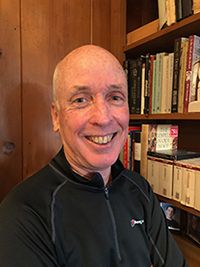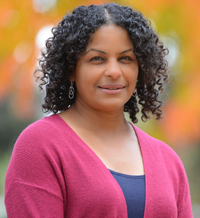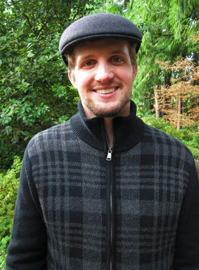From Our Archives
For earlier essays on this week's RCL texts, see Dan Clendenin, No Call Without Conflict (2022); Debie Thomas, She Stood Up Straight (2019); Dan Clendenin, Learning to Listen (2016), Jeremiah: Human Struggle with the Divine Call (2013), "He Put His Hands on Her”: The Compassion of Jesus Meets the Hypocrisy of Religion (2010), Sabbath-Keeping, Fasting, and “My Own Flesh and Blood” (2007).
This Week's Essay
By Amy Frykholm, who writes the lectionary essay every week for JWJ.
Hebrews 12:29: “For indeed, our God is a consuming fire.”
For Sunday August 24, 2025
Lectionary Readings (Revised Common Lectionary, Year C)
Psalm 71:1–6 or Psalm 103:1–8
Hebrews 12:18–29
Luke 13:10–17
As I write this, more than 40 large wildfires are burning across the United States and more than 60 in Canada. I am at this very moment sitting in smoke, smelling distant burning trees, as I am sure many of you are. The largest fire in the United States is a devastating one: the Dragon Bravo fire, which has upended many summer travel plans for people who wanted to visit the Grand Canyon. The Dragon Bravo fire has burned 143,563 acres, along with both the historic Grand Canyon Lodge and the North Rim Visitor Center. It has closed the park for the duration of the season.
This winter, in the Eaton fire that swept down from the San Gabriel Mountains in California, my friend Lisa (along with thousands of others) lost her house. It was the house she’d lived in for more than 20 years, where she’d raised her children. One day it was there, and the next morning when her husband went to check on it, it was gone.
The reality of wildfires gives us the opportunity to get up close and personal with what it means that “God is a consuming fire” (Hebrews 12:29). “You have not come to something that can be touched,” the writer of Hebrews says. “A blazing fire and darkness and gloom and a tempest” (12:18).
In the haunting first line of Toni Cade Bambara’s novel The Salt Eaters, the healer, Minnie Ransom, asks the protagonist, a burned-out activist named Velma who has just tried to kill herself by putting her head in an oven, “Are you sure, sweetheart, that you want to be well?”
The writer of Hebrews seems to be posing the same question, as Jesus does to the man by the side of the pool in John 5:6. What you’ve come to, the writer says, is not going to be easy to bear. This kind of God is not to be taken lightly, and the healing that is offered comes with more than a small amount of terror. It would be easier to stay in the imaginary light of self-deception than to enter the powerful, even overwhelming, presence of the holy.
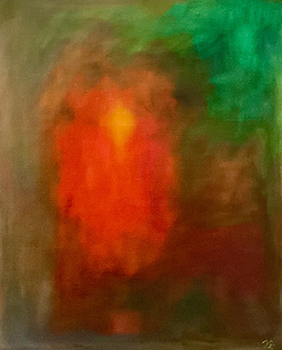 |
|
Vera Klimova, The Fire Is Inside (2021).
|
Velma is not at all sure she wants to be well. Her healing is going to come at a high price. She’s already tried just about every alternative. “Wholeness is no trifling matter. A lot of weight when you’re well,” Minnie Ransom says by way of warning.
When Lisa’s house burned to the ground, she noted with gratitude her family’s safety, that all of the things that the fire consumed were just things. Objects. But she also noted that objects hold memories; they hold feelings. The things that were lost included objects that had come from her ancestors — passed down mother to daughter for generations. Yes, we can find “what cannot be shaken” (Hebrews 12:27), but often only through tremendous loss.
If only, when the consuming fire came, we were able to keep all of the things we wanted to keep, all of the things we truly loved, and let the rest go. But that’s not how a consuming fire works. A consuming fire takes all of it: what we loved, what we were reluctant to release, what was sitting by the side door waiting to be delivered to the thrift store. It takes fresh wildflowers and ancient trees. It doesn’t differentiate between structures that had been built with love and intention and those that had been assembled cheaply or out of mere expediency.
At the same time, we know that wildfire in many contexts has important and beneficial effects. Certain trees require the extreme heat of the wildfire to regenerate. Their cones open in conditions created by fire so that seeds can spread. Serotinous cones, for example, are sealed shut by a waxy, fire resistant resin. The heat softens the resin that holds the cone scales shut, allowing them to release their seeds. Other trees require fire to clear space in the understory around them so that they can flourish. More than 500 trees the world over have a fire-related strategy for regeneration.
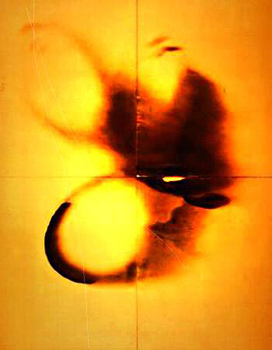 |
|
Yves Klein, Fire Painting F25 (1961).
|
Fire both takes away and it gives. Is it so with us? Are there certain things inside us that can only be brought into life by God’s fire? The writer of Hebrews seems to think so. Heaven and earth will be shaken, and only through its shaking will we find that which cannot be shaken. It’s a terrifying thought.
When we say that God is a consuming fire, I wonder: what exactly is consumed? What is not consumed? A consuming fire takes up everything that holds the past. If something belongs to the past or even to the very present moment, it is consumed — at whatever stage of its life. But the fire does not consume the future. In fact, it serves the future, releasing seeds from their cases and creating the conditions for future growth. This is what we need in order to be able to “receive the unshakable kingdom (12:28).
In The Salt Eaters, Bambara’s character Velma has a lot that must be surrendered to the consuming fire. She must give up closely held resentments, old stories, her well-earned angers, even the history of blood and rage that has been her people’s story. It’s not a trade-off that she is willing to accept at first. Only as she encounters the healing forces that Minnie Ransom represents, and sees deeply into how holding on to the past has cost her, is she able to begin.
Bambara writes that most people are “so used to being unwhole and unwell, one forgot what it was to walk upright and see clearly, breathe easily, think better than was taught, be better than one was programmed to believe… For people sometimes believed that it was safer to live with complaints, was necessary to cooperate with grief, was all right to become an accomplice in self-ambush.”
Just as our society has suppressed the fires that nature requires, believing that we could hold on to the past, so too have we internally clung to what keeps us “unwhole and unwell.” We’ve believed in the false safety of the past and thus become accomplices in self ambush.
This summer I visited a burn site not far from my house where two years ago a fire raged and threatened my brother-in-law’s house. It was started by campers who thought they had buried their campfire properly and put it out, but instead it burned underground for weeks before bursting into flame and consuming a mountainside.
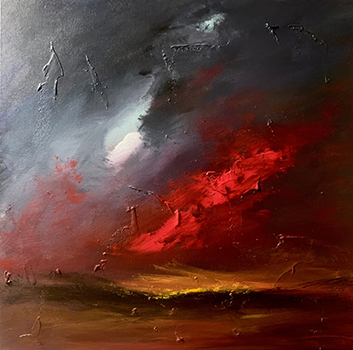 |
|
Lee Davis, World on Fire (2024).
|
I climbed up the path to the burn site cautiously, even though the fire had been out for more than a year. The site held a peculiar kind of quiet, and I became quiet too. The ground felt different under my feet. The trees around me were twisted and charred. I could see the fire line clearly. It was humbling to be in the midst of this vast, sprawling scar.
Yet already, the ground was carpeted in pale green. Aspen trees were the early adapters, making the most of the space that had been cleared. They seemed to be generating more seeds than usual, drooping long strings from their branches. Tiny sprouts surrounded their bases.
In The Salt Eaters, Minnie Ransom tells Velma that she must learn just how connected she is to everything else — to an “ecology of the self, the tribe, the species, the earth,” that her healing is intimately tied to the healing of the whole.
Once she knows that she is connected to powerful forces, she will “stride into the future sane and whole.” I picture this for the woman Jesus healed in Luke’s Gospel. The past had bound her tightly. Her limbs had become twisted from the crippling weight of her malady. Her body, after 18 years, had become accustomed to its brokenness and pain.
But now she is asked to walk upright and inhabit a new freedom. I imagine that it isn’t easy at all. Even though she now knows that she walks in the “heavenly Jerusalem” (Hebrews 23:22), as well as in the earthly one, she still has to find a new way of moving forward. She’s no longer crippled. That’s true. But she also doesn’t have the body she’d grown accustomed to. Free from bondage, she carries within her the broken-open seeds of a new future.
Weekly Prayer
David Whyte (b.1955)
And we know, when Moses was told,
in the way he was told,
“Take off your shoes!” He grew pale from that simplereminder of fire in the dusty earth.
He never recovered
his complicated way of loving againand was free to love in the same way
he felt the fire licking at his heels loved him.
As if the lion earth could roarand take him in one movement.
Every step he took
from there was carefully placed.Everything he said mattered as if he knew
the constant witness of the ground
and remembered his own face in the dustthe moment before revelation.
Since then thousands have felt
the same immobile tongue with which he tried to speak.Like the moment you too saw, for the first time,
your own house turned to ashes.
Everything consumed so the road could open again.Your entire presence in your eyes
and the world turning slowly
into a single branch of flame.David Whyte (b. 1955) is an Anglo-Irish poet who moved to the United States in 1981 and works for a deeper incorporation of poetry into American life. This poem is from River Flow: New & Selected Poems Revised Edition (Many Rivers Press, 2012).
Amy Frykholm: amy@journeywithjesus.net
Image credits: (1) Art Majeur; (2) Perfect Picture Lights; and (3) Art Majeur.



